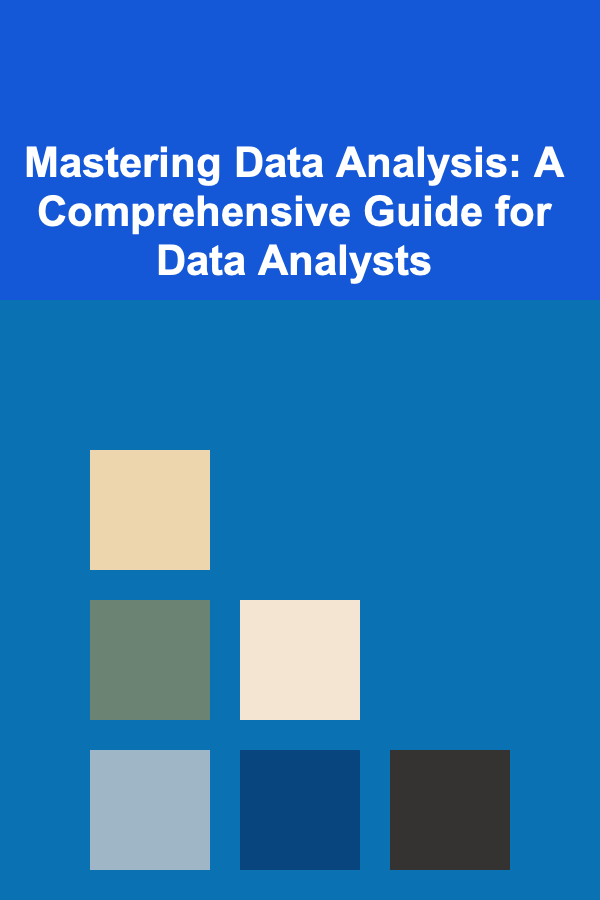
Mastering Data Analysis: A Comprehensive Guide for Data Analysts
ebook include PDF & Audio bundle (Micro Guide)
$12.99$9.99
Limited Time Offer! Order within the next:

Data analysis is a fundamental aspect of decision-making in today's data-driven world. As organizations collect more and more data, the demand for skilled data analysts continues to rise. These professionals transform raw data into valuable insights that drive business growth, improve efficiency, and help in strategic decision-making. However, becoming proficient in data analysis requires more than just technical expertise. It involves a deep understanding of the analytical process, problem-solving skills, and the ability to communicate insights effectively.
In this comprehensive guide, we will explore the core principles of data analysis, outline the essential skills and techniques every data analyst should master, and provide actionable steps for success in the field. Whether you're just beginning your journey as a data analyst or looking to sharpen your existing skills, this guide will serve as an invaluable resource.
Understanding the Data Analysis Process
The data analysis process involves several key stages, each designed to ensure that you extract meaningful insights from the data. These stages are iterative, meaning that you may revisit some steps as you refine your analysis. Here's an overview of the process:
- Problem Identification and Understanding: Before diving into data, it's essential to fully understand the problem you're trying to solve. Whether it's improving customer retention, forecasting sales, or optimizing a business process, understanding the context and objective is crucial.
- Data Collection: Once you have a clear understanding of the problem, you need to gather the relevant data. Data may come from various sources, including internal databases, APIs, or third-party providers.
- Data Cleaning and Preparation: Raw data is rarely perfect. It often contains errors, missing values, or inconsistencies that need to be addressed before analysis can take place.
- Exploratory Data Analysis (EDA): In this step, you explore the data through summary statistics, visualizations, and patterns to gain insights and form hypotheses.
- Statistical Analysis and Modeling: After exploring the data, you apply statistical methods or build models to answer your research questions, make predictions, or test hypotheses.
- Interpretation and Communication: The final step is interpreting the results in the context of the problem and communicating your findings to stakeholders in a clear, actionable manner.
By following this structured approach, you can ensure that your analysis is both thorough and effective, leading to valuable insights that support business decisions.
Key Skills for Data Analysts
Mastering data analysis requires a combination of technical skills, domain knowledge, and problem-solving abilities. Below are the key skills every data analyst should develop to excel in their role:
1. Statistical Knowledge
A deep understanding of statistics is fundamental to data analysis. Whether you are analyzing trends, testing hypotheses, or building predictive models, statistical methods are central to drawing valid conclusions from data. Key statistical concepts you should master include:
- Descriptive Statistics: Calculating measures like mean, median, standard deviation, and variance to summarize and understand the distribution of your data.
- Inferential Statistics: Techniques such as hypothesis testing, confidence intervals, and p-values help you make inferences about a population based on sample data.
- Regression Analysis: Used to model the relationship between dependent and independent variables. Linear regression, multiple regression, and logistic regression are common techniques.
- Probability: Understanding probability distributions, Bayes' theorem, and other probability concepts is crucial for making informed predictions and decisions.
2. Data Manipulation and Cleaning
Data is often messy, and one of the most time-consuming aspects of analysis is cleaning and preparing it for use. As a data analyst, you need to be proficient in handling missing values, correcting errors, and transforming data into a usable format. Here are a few essential techniques:
- Handling Missing Data: Decide whether to remove or impute missing values depending on the amount of data missing and the potential impact on your analysis.
- Removing Duplicates: Duplicate records can distort your analysis, so removing them is a critical step.
- Data Transformation: You may need to normalize or scale data, convert data types, or derive new features to ensure that the dataset is ready for analysis.
- Using Tools : Proficiency in tools like Pandas (Python), SQL , and Excel can make the process of cleaning and preparing data more efficient.
3. Data Visualization
Data visualization is a powerful tool for communicating insights. Visualizing data can help identify patterns, trends, and outliers that might not be immediately obvious in raw data. Some important aspects of data visualization include:
- Creating Effective Visuals: Learn to use graphs such as bar charts, line graphs, scatter plots, histograms, and heatmaps to display your findings.
- Choosing the Right Chart: Select the appropriate type of chart or graph based on the data and the message you want to convey. For example, use line charts for trends over time and histograms for distribution analysis.
- Tools for Visualization : Tools like Matplotlib , Seaborn , and Tableau allow you to create interactive and informative visualizations that make your analysis more accessible to others.
4. Analytical Thinking and Problem-Solving
Data analysis isn't just about crunching numbers. It's about asking the right questions and making sense of the data in the context of the business problem. Analytical thinking involves:
- Breaking Down Problems: Deconstruct complex problems into manageable parts, making it easier to identify the right data and methods to apply.
- Hypothesis Formulation: Based on your understanding of the problem, form hypotheses that can be tested using data. These hypotheses will guide your analysis and help you focus on the most relevant aspects of the data.
- Pattern Recognition: Identifying trends and correlations in the data allows you to make informed decisions or predictions.
5. Programming Skills
While not all data analysts need to be expert programmers, a solid understanding of programming is essential for performing sophisticated analyses and automating repetitive tasks. Some key programming skills include:
- Python: Python is one of the most widely used languages in data analysis, with powerful libraries like Pandas, NumPy, and Matplotlib for data manipulation and visualization.
- R: R is another popular language for statistical analysis and data visualization. It's widely used in academic and research settings.
- SQL: SQL (Structured Query Language) is critical for extracting, manipulating, and analyzing data stored in relational databases.
Data Analysis Tools
A data analyst's toolkit includes a variety of software and tools to streamline the analysis process. Below are some essential tools you should consider mastering:
1. Python
Python is one of the most versatile and widely used programming languages in the data analysis field. Its libraries like Pandas, NumPy, and Matplotlib make it easy to manipulate data, perform statistical analysis, and visualize results. Python is particularly valuable when working with large datasets and complex analyses.
2. R
R is a language specifically designed for statistical analysis and data visualization. It is widely used in academia and research for data manipulation, visualization, and advanced modeling. R has a rich ecosystem of libraries, such as ggplot2 for visualization and dplyr for data manipulation, which make it a powerful tool for data analysts.
3. SQL
SQL is an essential skill for working with relational databases. It allows you to query databases, extract data, and manipulate it efficiently. SQL is particularly useful for working with structured data and performing aggregations and joins.
4. Excel
Despite the rise of more advanced tools, Excel remains a staple in many data analysis workflows. It's useful for basic data cleaning, exploration, and visualization. Its pivot tables, functions, and charting capabilities make it an invaluable tool for small to medium-sized datasets.
5. Tableau and Power BI
Both Tableau and Power BI are powerful business intelligence tools that allow you to create interactive dashboards and reports. They are user-friendly and allow you to visualize large datasets quickly, making them popular choices for data analysts who need to present their findings to non-technical stakeholders.
The Art of Communicating Insights
One of the most crucial skills for data analysts is the ability to communicate insights clearly and effectively. The purpose of analysis is to inform decisions, and if you can't communicate your findings in an understandable and actionable way, your analysis may not be as valuable as it could be.
Key Tips for Communicating Insights:
- Tell a Story: Frame your insights as a narrative. A clear story makes it easier for stakeholders to understand the significance of the data and take action.
- Use Simple Visuals: Avoid overwhelming your audience with complex charts and jargon. Use simple, clear visuals to illustrate your findings.
- Actionable Recommendations: Provide clear recommendations based on your findings. Don't just present data---explain what actions should be taken as a result of the insights.
- Context Matters: Provide the context for your analysis. Explain why certain trends are significant and how they impact the business.
Conclusion
Mastering data analysis is an ongoing journey that involves continuous learning and improvement. It requires a blend of technical skills, critical thinking, and effective communication. By developing expertise in statistical methods, data manipulation, visualization, and programming, data analysts can transform raw data into actionable insights that drive meaningful business outcomes.
Whether you're just starting out or looking to refine your skills, following the guidelines outlined in this guide will help you become a more effective data analyst. With the right tools and techniques, you can unlock the power of data and make informed, data-driven decisions that drive success.
Reading More From Our Other Websites
- [Home Pet Care 101] How to Prevent and Treat Fleas and Ticks
- [Personal Financial Planning 101] How to Balance Short-Term and Long-Term Financial Goals
- [Personal Investment 101] How to Start a Deep Learning Side Hustle for Passive Income
- [Trail Running Tip 101] The Mind‑Body Connection: Why Trail Running Becomes a Meditation in Motion
- [Home Holiday Decoration 101] How to Decorate a Small Space for the Holidays Without Overcrowding
- [Personal Investment 101] How to Analyze Market Trends and Make Informed Investment Choices
- [Home Security 101] How to Use Eufy Security for Smart Home Integration and Better Protection
- [Soap Making Tip 101] How to Choose the Right Oils, Lye, and Additives for Perfect Bars Every Time
- [Personal Care Tips 101] How to Apply Hand Cream for Soft and Smooth Hands
- [Home Budget Decorating 101] How to Decorate Your Home with Found Objects: Turning Trash into Treasure

How to Cut Back on Unnecessary Subscriptions and Save More
Read More
How to Optimize Under-Bed Storage for Extra Space
Read More
How to Set Up a Custom Closet System on a Budget
Read More
Making Money through Deep Learning: A Step-by-Step Guide
Read More
Navigating Employment Law in Recruitment: A Comprehensive Guide
Read More
10 Tips for Optimizing 3D Models for Game Engines
Read MoreOther Products

How to Cut Back on Unnecessary Subscriptions and Save More
Read More
How to Optimize Under-Bed Storage for Extra Space
Read More
How to Set Up a Custom Closet System on a Budget
Read More
Making Money through Deep Learning: A Step-by-Step Guide
Read More
Navigating Employment Law in Recruitment: A Comprehensive Guide
Read More